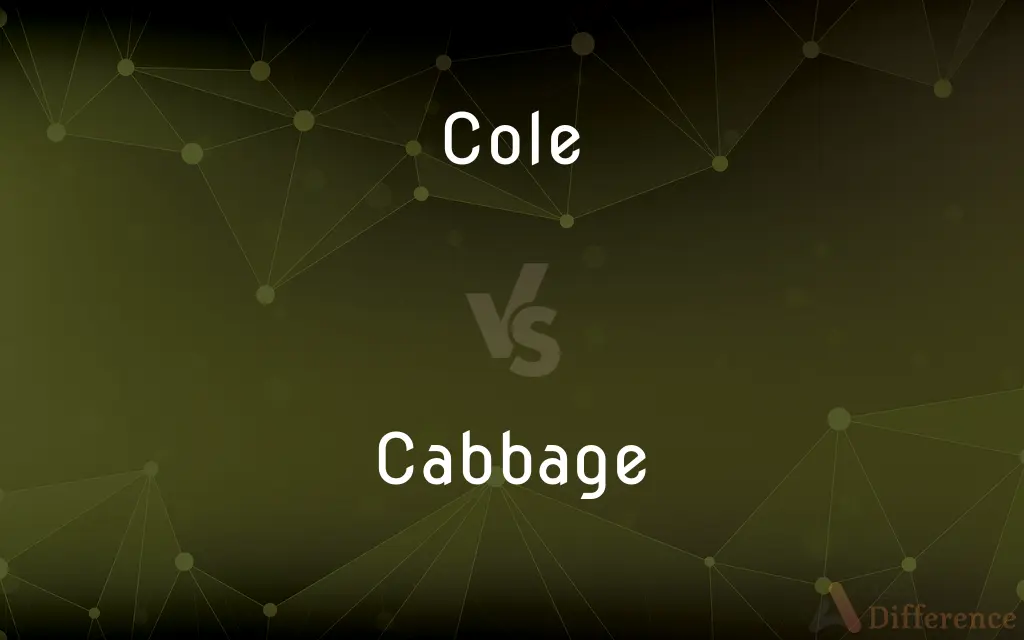Cole vs. Cabbage — What's the Difference?
Cole refers to plants of the Brassica genus, including various leafy greens and vegetables, whereas cabbage specifically denotes a type of cole cultivated for its dense-leaved heads.

Difference Between Cole and Cabbage
Table of Contents
ADVERTISEMENT
Key Differences
Cole encompasses a variety of plants from the Brassica genus, known for their edible leaves, stems, or flowers. These can include vegetables like broccoli, cauliflower, and kale, showcasing the diversity within the genus. On the other hand, cabbage is a specific member of this genus, recognized by its tightly formed, round or oval heads composed of superimposed leaf layers.
While cole plants offer a wide range of flavors, textures, and uses in cooking, from the slight bitterness of kale to the soft, floral notes of cauliflower, cabbage is generally milder in taste, making it versatile in dishes ranging from raw salads to slow-cooked meals. This difference in flavor profile highlights the culinary diversity between cole crops and cabbage.
Cabbage is specifically bred for its head formation, which is absent in many other cole crops like kale and Brussels sprouts that are grown for their leaves or buds, respectively. This distinction is important in agriculture and gardening, where different cultivation practices may be employed based on the plant's growth habits and desired edible parts.
In terms of nutritional content, both cole crops and cabbage are rich in vitamins and minerals, but the specific nutrient composition varies among the different types. For example, kale is notably high in vitamin K and calcium, whereas cabbage is often praised for its vitamin C content. This nutritional variation underscores the health benefits of incorporating a variety of cole crops into one's diet.
Despite their differences, both cole crops and cabbage share common benefits, including being low in calories, high in fiber, and containing compounds that have been associated with reduced risk of certain diseases. Their shared attributes highlight the value of both in a balanced diet for promoting overall health and well-being.
ADVERTISEMENT
Comparison Chart
Definition
Plants of the Brassica genus.
A type of cole with a dense head of leaves.
Varieties
Includes broccoli, kale, cauliflower, etc.
Primarily one variety with different cultivars (green, red, Savoy).
Culinary Uses
Diverse, ranging from raw to cooked in various dishes.
Often eaten raw in salads or cooked in a variety of dishes.
Growth Habit
Varied, depending on the plant (leafy greens, heads, or flower buds).
Grows as a head composed of tightly packed leaves.
Nutritional Value
Varies widely among different types; generally high in vitamins and minerals.
Known for high vitamin C content and other nutrients.
Compare with Definitions
Cole
Used widely in cooking for their distinct flavors and textures.
Broccoli, a cole crop, is often steamed or roasted as a side dish.
Cabbage
A leafy green or purple biennial plant, grown as an annual vegetable crop for its dense-leaved heads.
Cabbage is a staple ingredient in coleslaw, a popular side dish.
Cole
Any of various types of vegetable plants belonging to the Brassica genus.
Kale, a type of cole, is popular in salads and smoothies for its nutritional benefits.
Cabbage
Prefers cool climates and can be grown in both spring and fall.
Cabbage heads are harvested when they are firm and dense.
Cole
Many cole crops have been cultivated for centuries and have significant cultural importance in various cuisines.
Collard greens, part of the cole family, play a crucial role in Southern U.S. cuisine.
Cabbage
Commonly used both raw and cooked in a variety of dishes worldwide.
Sauerkraut is made from fermented cabbage.
Cole
Generally high in vitamins, minerals, and dietary fiber.
Brussels sprouts, a cole vegetable, are a good source of vitamin K and C.
Cabbage
Rich in vitamins C and K, dietary fiber, and antioxidants.
Eating cabbage can help improve digestion and support the immune system.
Cole
Cole crops can have varied growing requirements based on the specific plant.
Cauliflower requires cool temperatures and consistent watering for optimal growth.
Cabbage
Cabbage (comprising several cultivars of Brassica oleracea) is a leafy green, red (purple), or white (pale green) biennial plant grown as an annual vegetable crop for its dense-leaved heads. It is descended from the wild cabbage (B. oleracea var.
Cole
See kale.
Cabbage
Any of several forms of a vegetable (Brassica oleracea var. capitata) of the mustard family, having a globose head consisting of a short stem and tightly overlapping green to purplish leaves.
Cole
Cabbage.
Cabbage
Any of several similar or related plants, such as Chinese cabbage.
Cole
Brassica; a plant of the Brassica genus, especially those of Brassica oleracea (rape and coleseed).
Cabbage
The terminal bud of several species of palm, eaten as a vegetable.
Cole
(Scotland) A stack or stook of hay.
Cabbage
(Slang) Money, especially in the form of bills.
Cole
A plant of the Brassica or Cabbage genus; esp. that form of Brassica oleracea called rape and coleseed.
Cabbage
(Informal) Sweetheart; dear. Used as a term of endearment.
Cole
A hardy cabbage with coarse curly leaves that do not form a head
Cabbage
An edible plant (Brassica oleracea var. capitata) having a head of green leaves.
Cole
Coarse curly-leafed cabbage
Cabbage
(uncountable) The leaves of this plant eaten as a vegetable.
Cabbage is good for you.
Cabbage
A person with severely reduced mental capacities due to brain damage.
After the car crash, he became a cabbage.
Cabbage
Used as a term of endearment.
Cabbage
Money.
Cabbage
Marijuana leaf, the part that is not smoked but from which cannabutter can be extracted.
Cabbage
The terminal bud of certain palm trees, used for food.
Cabbage
The cabbage palmetto (Sabal palmetto), a palm of the southeastern US coasts and nearby islands.
Cabbage
Leftover scraps of fabric.
Cabbage
Scraps of cloth which are left after a garment has been cut out, which tailors traditionally kept.
Cabbage
(intransitive) To form a head like that of the cabbage.
To make lettuce cabbage
Cabbage
To do nothing; to idle; veg out.
Cabbage
(transitive) To purloin or embezzle; to pilfer, to steal.
Cabbage
An esculent vegetable of many varieties, derived from the wild Brassica oleracea of Europe. The common cabbage has a compact head of leaves. The cauliflower, Brussels sprouts, etc., are sometimes classed as cabbages.
Cabbage
The terminal bud of certain palm trees, used, like, cabbage, for food. See Cabbage tree, below.
Cabbage
The cabbage palmetto. See below.
Cabbage
Cloth or clippings cabbaged or purloined by one who cuts out garments.
Cabbage
To form a head like that the cabbage; as, to make lettuce cabbage.
Cabbage
To purloin or embezzle, as the pieces of cloth remaining after cutting out a garment; to pilfer.
Your tailor . . . cabbages whole yards of cloth.
Cabbage
Any of various types of cabbage
Cabbage
Informal terms for money
Cabbage
Any of various cultivars of the genus Brassica oleracea grown for their edible leaves or flowers
Cabbage
Make off with belongings of others
Common Curiosities
What are cole crops?
Cole crops are vegetables of the Brassica genus, which includes a variety of leafy greens and other plants like broccoli and cauliflower.
Is cabbage easy to grow?
Cabbage is relatively easy to grow in cool weather and can be a rewarding vegetable for home gardeners.
How long does it take for cabbage to mature?
Depending on the variety, cabbage typically matures in about 70 to 85 days from transplanting.
How does cabbage differ from other cole crops?
Cabbage specifically refers to plants grown for their dense-leaved heads, unlike other cole crops that may be grown for their leaves, flowers, or stalks.
Are there any health risks associated with eating cole crops?
While generally healthy, consuming large amounts of some cole crops can interfere with thyroid function in susceptible individuals.
Can cole crops be grown in containers?
Many cole crops, including smaller cabbage varieties, can be successfully grown in containers with proper care.
What are some popular dishes made with cabbage?
Popular dishes include coleslaw, sauerkraut, and stuffed cabbage rolls.
Can I substitute cabbage for kale in a recipe?
While substitutions can be made, differences in texture and flavor between cabbage and kale should be considered in the context of the recipe.
Are all cole crops equally nutritious?
While all cole crops are nutritious, their vitamin and mineral contents vary, making a diverse diet important for maximum health benefits.
What's the best way to cook cabbage to preserve its nutrients?
Steaming or sautéing cabbage can help preserve its vitamin C content better than boiling.
What pests commonly affect cole crops and cabbage?
Pests such as cabbage loopers, aphids, and flea beetles can affect both cabbage and other cole crops.
How do I store cabbage to keep it fresh?
Store cabbage in the refrigerator, ideally in a crisper drawer, to maintain its freshness for weeks.
Can I freeze cabbage?
Yes, cabbage can be frozen after blanching, though it may change the texture.
Do cole crops need full sun?
Most cole crops prefer full sun but can tolerate partial shade, depending on the specific plant and growing conditions.
Why is kale considered a superfood among cole crops?
Kale is dubbed a superfood due to its high nutrient density, particularly in vitamins A, K, and C, as well as antioxidants.
Share Your Discovery

Previous Comparison
Collage vs. Mosaic
Next Comparison
Procedure vs. Routine













































